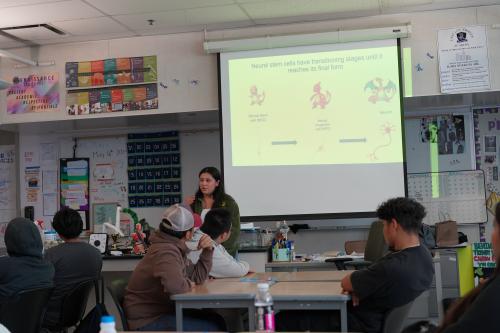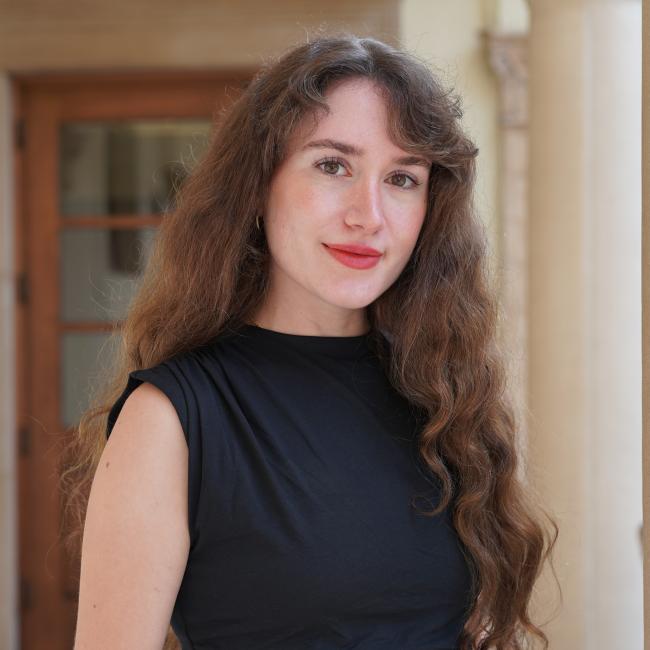
Cultivating curiosity: High school outreach program sparks interest in STEM
This May, UCLA graduate students, postdoctoral scholars and early-career physician scientists presented their research to an audience they don’t often get the chance to interact with: high school students.
The presentations are an integral part of the Eli and Edythe Broad Center of Regenerative Medicine and Stem Cell Research at UCLA’s High School Outreach Program, which launched in 2023 with a mission to enable students of all backgrounds to see themselves in a STEM field. The program has reached more than 400 students across two Los Angeles County public high schools so far.
These outreach sessions have also given trainees of the UCLA Broad Stem Cell Research Center Training Program a platform to hone science communications skills they’ve developed through a series of workshops.
During their in-classroom visits, the trainees covered the basics of stem cell biology and presented their research using clever analogies like comparing the transition stages of neural stem cells to a Pokémon’s evolution.
They also shared challenges they’ve encountered while pursuing a career in STEM, “Day in the Life” videos showing life as a research scientist both inside and outside of the lab and answered students’ questions about college and different pathways in science.
Nicole Bottomley, a biochemistry teacher at the Odyssey STEM Academy in Lakewood, California, has seen how new information sticks best for her students when the learning takes place outside of textbooks.
“It’s powerful for them to see real scientists asking questions and coming up with solutions that are useful in our everyday lives,” she said.
Here, the center’s trainees who led these visits share their views on the importance of high school outreach and the lessons they’ve gained from the experience:

Jessenya Mil
Graduate student in the lab of Aparna Bhaduri, Ph.D.
UCLA Broad Stem Cell Research Center trainee
California Institute for Regenerative Medicine Scholar
It was rewarding to present to a classroom with a majority of Latino students so that I could give back to my community. I’m sure a lot of them could relate to my story as a first-generation student whose parents immigrated to the U.S. Coming from my background, it wasn’t really ever expected of me to be a graduate student, so I wanted to show the students that if I can do it, so can they. I see it as my responsibility to expose students, especially those who aren’t surrounded by people who participated in higher education, to different careers within science.
▶️ Watch Jessenya Mil’s "Day in the Life" video

Tyler McCaw, M.D., Ph.D.
Clinical fellow in the lab of Joseph Crompton, M.D., Ph.D.
UCLA Broad Stem Cell Research Center trainee
California Institute for Regenerative Medicine Scholar
We’re unfortunately in a time where there’s a lot of social distrust in science. I think it’s really important for us [as scientists] to get out into the community and engage with students at younger ages to shift the conversation about science and its role in society. Besides that, outreach matters to me personally because I had mentors and peers who helped me during my training process and now I want to pay that kindness forward. I also wanted to pull the curtain back a little and show the students that participating in science is accessible and possible at any age. Hopefully that breaks down some barriers by just letting them know that there are tons of different ways to pursue a science career.

Natella Baliaouri
Graduate student in the lab of Bennett Novitch, Ph.D.
UCLA Broad Stem Cell Research Center trainee
California Institute for Regenerative Medicine Scholar
When younger people see someone who’s more established, it’s easy for them to think that what this shiny person has accomplished is out of reach for them. Being aware of this, I started my presentation by sharing some of the challenges in life I’ve had to contend with. I enjoyed fielding questions from the students about lab life, neuroscience research and how to find community in college. Whenever I can, I try to participate in K-12 outreach activities to show how cool science can be. Each of these experiences has solidified my desire to go into teaching, particularly at the community college level where I can have more of a direct impact on students.

Carlos Galván
Graduate student in the lab of William Lowry, Ph.D.
UCLA Broad Stem Cell Research Center trainee
The Rose Hills Foundation Graduate Scholar
In my community, college wasn’t the norm after high school, entering the workforce was. Looking back, the odds were stacked against us, but I’m also proof that you can pull yourself out of that environment and really do something impactful. I didn’t learn about certain careers such as a research scientist until college, so introducing different career options to students in high school could really make a difference in their trajectory. I also think it’s nice for them to see that a lot of the volunteers are people of color like them, who come from backgrounds like theirs because that visibility can start to reshape their vision of what a scientist looks like.
▶️ Watch Carlos Galván’s "Day in the Life" video

Eva Segura
Graduate student in the lab of Donald Kohn, M.D.
UCLA Broad Stem Cell Research Center trainee
The Rose Hills Foundation Graduate Scholar
I went to community college after high school and didn’t have a straight path to becoming a researcher. I hope my story resonated with the students who don’t really have the most confidence in themselves in terms of schooling. What’s important is to develop a strong work ethic and keep moving forward — that was my main message. My other goal was to just expose them to the greatness of science and show them how stimulating and impactful a career in STEM can be. This opportunity to interact with high school students has been really gratifying because it’s always such a meaningful experience to do something that’s beyond your project or thesis.

Christopher Ochoa
Graduate student in the lab of Sanaz Memarzadeh, M.D., Ph.D.
UCLA Broad Stem Cell Research Center trainee
The Rose Hills Foundation Graduate Scholar
When you’re just heads down working on your own research project, sometimes you can lose sight of how your work in the lab translates to the direct benefit of others. This opportunity to connect with so many high school students has really reenergized me. My goal was to show the students that if I, a regular person who’s not a genius by any means, would go to graduate school and work in cancer research, then they can too. I also wanted them to be aware of the different paths available to them. Speaking from my own experience, I didn’t know that graduate programs existed until my last semester of community college or that many programs would be paid for by grants. I might not have chosen this route if I didn’t have those touchpoints back then.

Yanruide (Charlie) Li, Ph.D.
Postdoctoral scholar in the lab of Lili Yang, Ph.D.
UCLA Broad Stem Cell Research Center trainee
California Institute for Regenerative Medicine Scholar
Previously in China, I had experience teaching biology and cancer therapy to middle and high school students. Since I want to eventually become a professor, this was good practice for me to communicate with American students. I enjoyed introducing them to cancer immunotherapy because the more they’re aware of different fields, the more information they have to choose their majors in college. And that’s what I think this program is about, which is to expand the students’ options by informing them of various different opportunities that are out there for them. The high school students asked really smart questions about new technologies advancing cancer research. I felt a sense of achievement by seeing them so interested in this field of research. Who knows, maybe I helped them choose a future career.
More than half of the high school students who attended these talks stated that the outreach activities increased their interest in pursuing a science career. But for some like Angel Cos, a 10th grade biology student at the East Los Angeles Renaissance Academy in Los Angeles, the impact of the presentations goes beyond what’s measurable: “Learning about his [Carlos Galván] life story motivates me to do better for myself.”
Building on this momentum, the outreach program is now inviting high school students to the UCLA campus for lab tours, hands-on science experiments and conversations with center faculty, trainees and staff scientists — furthering its mission to promote diversity in and increase accessibility to STEM careers.
“Outreach is important because working in low-income, brown and black communities, our students are focused on surviving instead of thriving. They don't have many opportunities to think about the future, and when they do, it's very limited,” said Sonia Perez, a biology teacher at the East Los Angeles Renaissance Academy. “Having young people who come from backgrounds like theirs come talk to them during this pivotal time in their lives can really open their eyes to all the opportunities that they have access to.”
